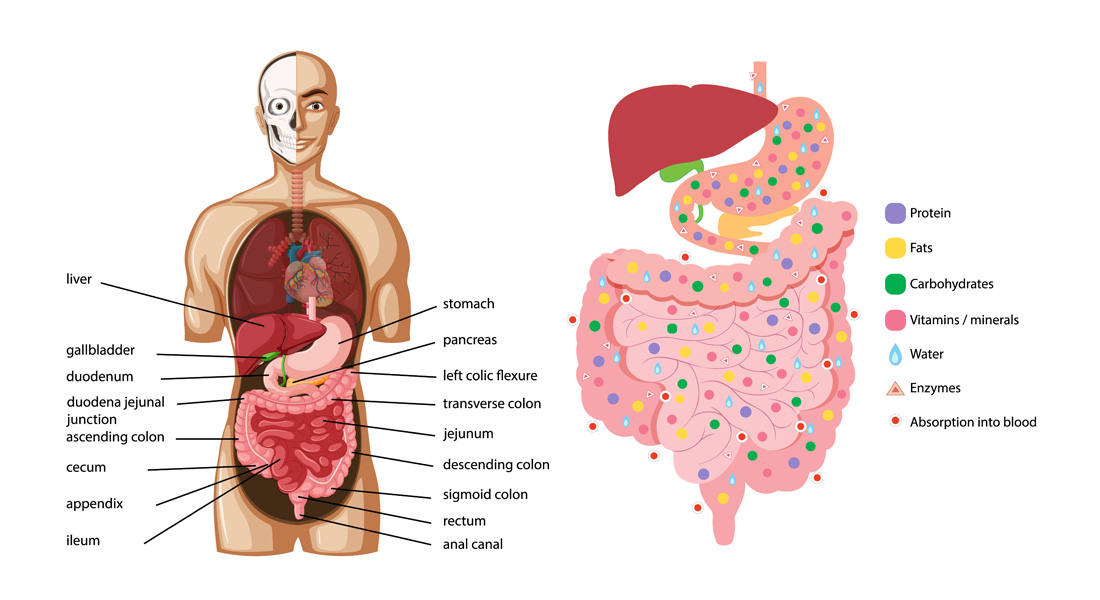Digestive System Physiology
Digestion refers to the process of breaking down large, complex organic molecules into smaller, simpler components that can be used by the body for energy, growth, and repair. These molecules must be broken down to a small enough size to diffuse across the plasma membranes of cells, enabling absorption and utilization by body tissues.
Stages of Digestion
-
Ingestion:
- The process of taking food or nutrients into the body through the mouth.
- Involves chewing and swallowing, preparing food for further breakdown.
-
Digestion:
- Chemical breakdown of large organic molecules into smaller subunits through the action of digestive enzymes.
- Proteins are broken into amino acids, carbohydrates into simple sugars, and lipids into fatty acids and glycerol.
-
Absorption:
- The transport of digested nutrients across the lining of the gastrointestinal tract into the bloodstream or lymphatic system, from where they are distributed to the body's tissues.
-
Assimilation:
- The process by which absorbed nutrients are utilized by body cells for energy, growth, and repair, converting them into body substances.
-
Egestion:
- The elimination of undigested or indigestible food materials (waste) from the body through the anus, as feces.
The Esophagus
- Structure: Approximately 10 inches long.
- Function:
- Secretes mucus to lubricate food.
- Moves food from the throat (pharynx) to the stomach via peristalsis, a series of wave-like muscle contractions.
- Note: Acid reflux (or heartburn) occurs when stomach acid enters the esophagus, causing irritation.
The Stomach
- Structure: A J-shaped muscular organ located in the upper abdomen.
- Function:
- Stores and churns the food to break it down mechanically.
- Mixes food with digestive juices, including hydrochloric acid (HCl) and digestive enzymes, particularly pepsin for protein digestion.
- Kills bacteria with stomach acid.
- Converts food into a semi-liquid form called chyme for easier passage to the small intestine.
The Small Intestine
- Structure: Roughly 7 meters long, divided into three main parts: the duodenum, jejunum, and ileum.
- Function:
- Chemical digestion occurs primarily in the duodenum, the first section. The pancreas and liver contribute enzymes and bile, respectively, which aid in breaking down nutrients.
- Absorption: Most of the nutrient absorption occurs here. The walls are lined with finger-like projections called villi. Each villus is covered with even smaller projections called microvilli, which increase the surface area for maximum nutrient absorption.
- Process:
- Food enters the small intestine as chyme from the stomach.
- The acidic chyme is neutralized in the small intestine by the secretion of bicarbonate ions from the pancreas.
- Hormones like secretin and cholecystokinin (CCK) regulate the release of digestive enzymes and bile, ensuring efficient digestion and absorption.
The Large Intestine (Colon)
- Structure: About 5 feet long, larger in diameter than the small intestine.
- Function:
- Absorbs water and electrolytes from indigestible food matter.
- Forms and stores feces, which are later expelled through the rectum and anus.
- Houses beneficial bacteria that help further break down certain substances.
The Rectum and Anus
- Rectum: Acts as a temporary storage site for feces before defecation.
- Anus: The external opening of the digestive tract, controlled by sphincter muscles. During defecation, the sphincters relax, allowing waste to exit the body.
Accessory Organs of Digestion
These organs contribute essential substances to aid digestion but do not directly come into contact with food.
-
Salivary Glands:
- Produce saliva, which contains enzymes (like amylase) that begin the breakdown of carbohydrates.
- Types:
- Parotid glands: Produce a serous, watery secretion.
- Submaxillary (mandibular) glands: Secrete both serous and mucous fluids.
- Sublingual glands: Produce mainly mucous secretions.
-
Liver:
- The largest gland in the body, constantly producing bile.
- Bile aids in digesting fats by emulsifying them (breaking them down into smaller droplets), which allows for easier enzyme action.
- Bile is stored in the gall bladder and released into the small intestine when needed.
-
Gall Bladder:
- Stores bile produced by the liver and releases it into the small intestine when fats are detected, regulated by the hormone cholecystokinin (CCK).
-
Pancreas:
- Secretes digestive enzymes and bicarbonate ions into the small intestine to help break down carbohydrates, proteins, and fats.
- Amylase from the pancreas breaks down carbohydrates into disaccharides, while trypsinogen and other enzymes break down proteins into amino acids.
- Bicarbonate neutralizes acidic chyme, raising the pH to allow optimal enzyme function.
Absorption of Nutrients
- Villi Structure:
- Each villus contains a capillary network and a lacteal (a lymphatic vessel).
- End products of carbohydrate and protein digestion (simple sugars and amino acids) enter the capillary network and are transported to the liver via the bloodstream.
- End products of fat digestion (fatty acids and glycerol) are absorbed into the lacteal and eventually enter the lymphatic system before being circulated in the bloodstream.



Free Videos